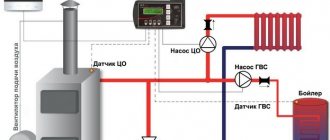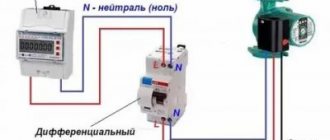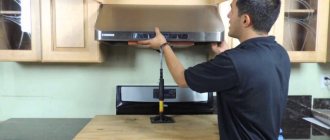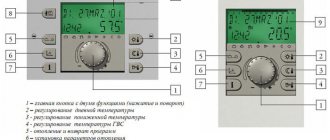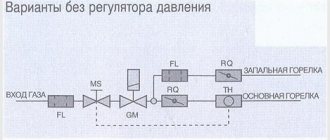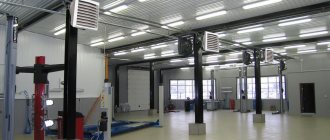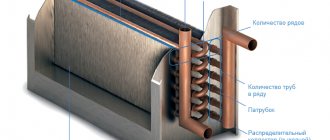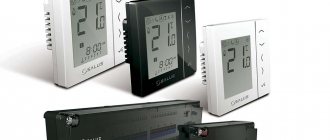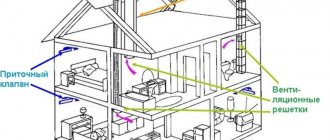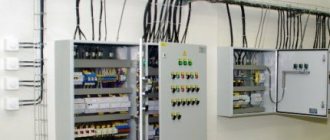Selecting a fan and starting method
There are many models of exhaust fans on the market, including those for the bathroom.
They differ not only in size and appearance. There are a number of characteristics that should be taken into account when choosing and purchasing. Bathroom fans come in overhead and ducted types, with a solid front panel or grille, in different colors and designs. The first thing that determines the connection diagram of a fan for extracting air from a bathroom is the way it is started.
Depending on the model, there are the following options:
- Turning on the fan body with a button or a cord - they are the easiest to connect, but reaching up to the ceiling every time is not very convenient.
- Starting with a separate switch or in parallel with lighting. The fan itself also has only 2 wires, but the possible connection diagrams are more complex and varied. Including, with an external timer or hygrometer, motion or door opening sensor.
- Control via built-in timer or hygrometer. Such models are connected with a three-wire wire.
- Remote control via remote control. These models combine the ease of connection of the first option and maximum ease of use, but they are also the most expensive.
In addition, not every exhaust fan is suitable for a bathroom. The fact is that this is electrical equipment, and to work in conditions of high humidity, the protection class must be at least IP45, which is confirmed in the documents. In this case, each digit of the marking should be taken into account separately, that is, IP62 protection is not suitable, since the second digit indicates resistance to moisture; it must be at least 5.
In practice, protection is implemented in the form of insulated connection contacts, a hidden or moisture-resistant control board, and a sealed motor housing. Even fans with high moisture protection characteristics are not recommended to be placed in such a way that water can enter them
You should also decide on the type of device design. Axial models are cheaper, but noisier because the air passes directly through them. Centrifugal fans form vortex flows that push air in a circle - this is much quieter. In addition, for a private house you can choose which ones are installed inside the ventilation duct, and not at the exit from it.
Another critical parameter is the power and performance of the fan. To do this, the volume of the room must be multiplied by 6 - 8, depending on the number of residents. The resulting figure is the minimum required volume of air exchange per hour.
A fan that is too weak will not do its job well and will have to be left on for a long time. Too powerful will not only add strong drafts, but can also provoke a reverse flow of air from the common ventilation shaft, with all the neighboring odors.
Also pay attention to the diameter of the fan. If it does not match the diameter of the existing ventilation hole, installation will require additional pipe and construction foam or a hammer drill, as well as significantly more effort.
The comfort of use is significantly affected by the noise of the equipment. Quiet models produce no more than 25-30 dB, less successful solutions produce about 50 dB, and sometimes more.
The non-return valve will protect you from odors and moisture from the neighbor's bathroom when the fan is turned off. It also partially protects the device from dust in the mine
In addition to the above parameters, pay attention to whether the fan is equipped with a check valve, a ventilation function, a mode switch, and a display indicating temperature and humidity. Design solutions include original or replacement protective panels, sometimes backlit.
Choosing a bathroom fan
Before you connect the bathroom fan to the switch, you need to select and purchase it. There are different criteria by which this device is selected.
Productivity
According to sanitary standards, for high-quality ventilation of the bathroom, an air exchange of at least 25 m³/h is required . This is stated in table 9.1 of SNiP 31-01-2003 “Residential multi-apartment buildings”.
With constant operation of the hood, a fan of any power is sufficient for this, but usually these devices operate for a short time, so it is advisable to choose a device with greater productivity.
After taking a bath or shower, it is advisable to replace all the warm, humid air with new, dry and cool air. Therefore, when using a timer, it is advisable to coordinate the performance of the hood, the volume of the room and the switching time so that a complete replacement of air is carried out in one turn on of the device according to the formula LxWxH=Pxt, where:
- L, W, H - length, width, height of the room in meters;
- P - productivity in m³/h;
- t—on time in hours.
Noise level
If electrical appliances in the apartment make a lot of noise during operation, then this is uncomfortable, especially at night. However, the exhaust fan in the bathroom is behind a closed door, and all household appliances have a reduced noise level.
Problems are possible if you choose an industrial exhaust device instead of a household one. In the manufacture of these devices, priority is given not to reduced noise levels, but to performance. For home use, exhaust fans with a noise level of 25–40 dB are suitable (up to 25 dB is very quiet, up to 40 dB is moderately audible).
| Advice! Alternatively, before purchasing, ask the seller to connect the fan and listen to how loud it will work. |
dimensions
The dimensions of this device depend on its diameter, which is limited by the cross-section of the ventilation shaft. To determine it, it is necessary to remove the protective grill and measure the width of the shaft and the wall thickness. It is these parameters that limit the size and performance of the device.
For comparison, the minimum diameter of the fan pipe is 80 mm, and the maximum is 200 mm. But choosing the right diameter for your size is not always possible. I advise you to take an air exchanger with a smaller pipe diameter, and seal the remaining space with putty or foam. This is better than breaking down the wall for a larger fan.
Electrical safety (degree of protection)
According to GOST R 50571.7.701-2013, the bathroom room is divided into zones according to the danger of water getting on electrical appliances and the required degree of protection from external conditions IP.
The choice of this parameter in the bathroom depends on the zone in which the devices are used from IPx7 in zone “0” to IPx1 in zone “3”, therefore, before connecting the fan in the bathroom to the switch, you must select an installation location for it.
However, the division of the room into zones is limited to a height of 2.25 meters, and the hood is located above this level, which allows the use of fans of any type.
| Advice! For a bathroom, electrical equipment must have a degree of protection of at least IP44. |
Power
The electrical power consumption of such devices is not high and ranges from 8 to 20 W. This indicator depends on performance. The greater the productivity, the correspondingly greater the power.
Additional functions
Household exhaust fans can be equipped with various additional devices that allow you to automate the process of turning on and off:
- humidity, motion and lighting sensors;
- remote controls;
- power adjustment;
- timer.
These devices affect the cost of the device, so before purchasing a device it is necessary to determine the list of necessary functions.
Installation features
The fan is connected to a two-wire wire. First, remove the front panel from the device. A groove is laid from the distribution panel to the ventilation hole. It must be strictly vertical or horizontal, without inclined lines.
The groove for laying electrical wiring is located no closer than 10 cm to the doorway. The cable is fixed with alabaster or cement mortar. The power supply line can be run inside the corrugated pipe.
The fan terminals are marked in English:
- L - phase.
- N - zero core.
- T - for connecting the signal wire. Used in models with a timer.
The veins vary in color. Zero is blue, the phase is in brown or white insulation. They must be correctly connected to the fan terminals and check the reliability of the contact. There are 4 holes for screws or self-tapping screws on the device body. Fastening elements are included in the delivery set. The fan can also be mounted on tiles without drilling. Silicone glue is suitable for this. You can use liquid nails.
Ceiling installation
Ceiling hood in the bathroom
In some homes, the electric fan may be mounted on the ceiling. In private houses, the ventilation duct is laid in the attic, therefore the ventilation system is located there.
Installation on a suspended or suspended ceiling becomes more complicated. On a suspended ceiling you will need to make a special stand, and the cooler can be screwed to the plasterboard using dowels. If the ceiling is already installed, dismantling will be required. To avoid dismantling the ceilings, you can use one of two methods:
- pulling wires through a hole that will need to be sealed later;
- run the wiring along the ceiling and hide it with a cable duct.
Installing a fan in the ventilation duct
Before final installation of the fan, it is necessary to lay an electrical cable to the connection point in advance. The cable is laid in a groove from the distribution box. Next, the cable cores are connected to the fan in accordance with the marked terminal designations. The neutral conductor is connected to the terminal marked N, the phase conductor is connected to terminal L. If the fan has a timer, the signal conductor is connected to the corresponding terminal.
Before installing the fan in the duct, remove the decorative panel. If the fan is attached to the wall with self-tapping screws, first drill holes for the dowels. The ventilation unit is fastened to the wall by screwing self-tapping screws into the dowel. The dowels must first be inserted into the holes. If it is not possible to mount the fan with self-tapping screws, installation is carried out using special glue or sealant. After the fan is securely installed, the decorative panel is installed.
Checking natural ventilation
You should start by finding the ventilation hole (shaft) and cleaning it, since small debris, dust and even cobwebs can accumulate there over the years. After checking and putting the vent in order, do the following maneuver: light a match or candle and bring it to the ventilation vent. If the flame flickers towards the hole, then everything is in order with your natural ventilation. For some, this method of checking may seem insufficient, then you should turn to another: take a small sheet of paper and lean it against the shaft: it is held up by the air flow - excellent, if it slides to the floor - the air flow is insufficient or there is none at all.
If there is no opening for natural ventilation in your bathroom, be sure to report this to the utility services.
In case of low flow, we recommend using a fan and installing it in the ventilation shaft hole. This device is represented by a wide range on the market of electrical household appliances, but the axial fan is in greatest demand. In addition to the type of design, you should also choose its size (depending on the size of the air vent) and the manufacturer, after which you can begin connecting yourself. This is not so difficult to do, so below we will look at several ways to connect it yourself.
Hood connection options
There are several options for connecting a bathroom fan to a switch. All these methods are best organized during the construction or major renovation stage. In this case, all the wires will be hidden under the plaster or tiles, and the appearance of the bathroom will not be affected. You can, of course, organize the installation of the hood after repairs, but in this case the design will be spoiled by installing a box for the fan power wires.
The following hood connection options are used:
- The fan is connected in parallel to the bathroom lighting. In this case, the device will turn on simultaneously with the lighting. The hood will work until the lights are turned off. The advantage of the method: ease of installation, low cost of execution. The main disadvantage is the dependence on the lighting. For optimal ventilation, you will need to leave the lighting on, and this will entail additional energy costs. The disadvantage of this method is the presence of a constant draft, which can affect the health of the person there.
- Basically, the hood is connected via a separate switch (one-key or two-key). This scheme has a clear advantage - no electricity will be wasted on useless lighting, and the fan will only work when necessary. A two-key switch is used when using a ventilation device in conjunction with lighting, when one key turns on the hood and the other switches on the light bulb. The disadvantage of the scheme is a slightly higher cable consumption than in the first option.
- The most modern hoods include a motion sensor, a humidity sensor, and a shutdown timer. A fan with a timer, in addition to the neutral and phase terminals, has a terminal for connecting a signal wire. The signal wire is usually connected to the lighting line. Such a fan can start, for example, after turning off the lighting and run for a specified period of time. The fan can be connected via a switch with any number of keys.
Connecting a bathroom fan via a switch
Most bathrooms do not have outside windows, the opening of which can ventilate and dry the room, therefore, in the absence or insufficiently strong draft in the ventilation duct, the air humidity in the bathroom exceeds 60%. This leads to the appearance of mold on the walls and ceiling and an unpleasant odor. In addition, according to the PUE clause 1.1.13, such rooms are classified as rooms with an increased risk of electric shock.
To solve these problems, it is advisable to install forced ventilation in addition to natural ventilation. In apartments and private houses, for this purpose, exhaust fans are installed in the exhaust vent of the ventilation duct.
| Important! Installation of a forced ventilation system does not cancel the division of the bathroom into zones in accordance with GOST R 50571.11-96 Section 701 “Bathrooms and shower rooms”. |
Before connecting the bathroom fan to the switch, you need to check the draft in the ventilation shaft. To do this, specialists, using a special mirror, try to see the sky through the ventilation duct, but in the absence of such a device, it is enough to bring a piece of paper or a burning match to the grille - the paper will be attracted to the grille, and the flame should deflect.
If this does not happen, then it is necessary to invite specialists to clean the shaft, otherwise installing a fan will not make any sense.
Connecting a fan with a timer
Units equipped with a timer are easy to use.
The operating principle of such a device is as follows:
- The fan starts in parallel with the lighting.
- After the light turns off, the unit rotates for a user-specified time, removing exhaust air from the room.
- Then it turns off automatically.
To ensure full functioning of the device, 4 cores are used:
- phase from the distribution panel;
- electrical wire connected to the light bulb;
- ground loop;
- zero core;
For self-installation, it is recommended to purchase a surface-mounted device with the necessary set of built-in sensors - humidity, motion, etc.
To a single-key switch
You can turn on lighting and ventilation with one button, but with a slight delay in starting the climate control unit. Some models are equipped with an electronic timer. Such devices provide the ability to select a functional mode. Their switch is implemented in the form of 3 pin contacts. Two of them are closed with a jumper - a special jumper. One mode is called "toilet". To activate it, the upper and middle contacts are closed.
The meaning of this mode is that when power is applied, the motor of the ventilation unit starts immediately. The second mode is called “bathroom”. The light turns on immediately after pressing the switch key, and the cooler starts working with a set delay. In this mode, the unit will start only if the time interval between turning the lighting on and off is at least 90 seconds.
To two-button switch
Two keys make it possible to control the cooler and lighting separately. Ventilation can work separately from lighting until the bathroom is completely ventilated.
When installing a two-button switch in the distribution box, additional connections appear:
- contact between the zero phase of the wire and the zero of the lighting;
- connecting the phase core of the lamp to the wire coming from the second output terminal of the switch.
Switching the switch into two keys is carried out as follows:
- the zero from the ventilation is connected to the neutral network wire;
- the exhaust phase is connected to the phase of the wire connected to one of the output terminals of the switch;
- the power supply wire is connected to the input terminal of the two-key switch;
- The bathroom lighting is switched to the second output terminal.
Tips for buying a fan with a hygrostat
A high-quality bathroom exhaust fan should be silent, have high performance, be protected from water and be suitable for the interior of the room. Variants with interesting designs and original designs of front grilles and panels are now being produced. Therefore, choosing an exhaust device for any style of bathroom decoration is not so difficult.
Duct fans are best suited for use in a bathroom or toilet. They are installed in the air duct. The blades of the products are made of metal or durable plastic. The design is not afraid of exposure to moisture, as well as caustic chemicals.
There are several variations of duct fans in shape. They come in round, square and rectangular. Select a model to match the shape of the exhaust duct in the room
A duct fan should be selected taking into account the parameters of the room and the diameter of the air duct. To select the performance of a product, first determine the volume of the room: to do this, multiply the width, length, and height of the room. The resulting value is multiplied by the standard air exchange rate.
The standard air exchange rate for showers and bathrooms is 7-9. If the room is used by several people, you should take the maximum value. Example: room volume 22.5 m3 *9 (air exchange rate) = 202.5 m3. In this case, you should buy a duct fan with a capacity of over 202.5 m3.
Channel systems also differ in other parameters: electric motor power, noise level, blade rotation speed, etc. Products are available in different colors, as well as types of decorative grilles.
Fans with a check valve are quite popular for installation in the bathroom. We recommend that you familiarize yourself with the ten best offers on the market.
Fan with built-in humidity sensor
There are 2 ways to connect devices equipped with a humidity sensor. One of them is designed for automatic operation.
- Zero is connected to terminal N.
- On L - phase.
- The fan is connected either through a switch or directly.
The device will operate continuously if the room humidity remains above 60%. If it drops to 50%, the device turns off. In this mode, the timer is not activated.
The second connection diagram option implies an extended operating mode. As in the previous version, phase is supplied to L, and zero to N. A jumper is installed between terminals 1 and L on which the switch is mounted.
When the circuit is closed, the device turns on and operates for a certain time, provided that the humidity is below 50%. If it is higher, the device will continue to operate until the moisture level drops to normal levels. Only then does the timer start.
The main tasks of automation for ventilation
Since the modern market offers a large number of various technical devices for ventilation automation, the range of their functions is also extremely wide.
Main functions of the control module equipped with elements of electronic intelligence:
- Maintaining the specified parameters of the microclimate of the interior - air temperature and humidity, carbon dioxide saturation, etc.
- Possibility for the operator to remotely control the fans, turn them on and off remotely.
- Implementation of automated control over the sensors of all components and assemblies of ventilation equipment.
- Independent transfer of equipment to summer or winter mode.
- Monitoring the level of contamination of filter devices with the function of signaling the need for cleaning.
- Opening and closing air duct dampers, adjusting the performance of supply and exhaust fans.
- Cutting off the fresh air supply when the fire alarm is activated.
- Turning off the power supply in emergency situations - sudden surges or drops in voltage. This allows you to prevent failure of devices, sensors and individual components of the ventilation system.
Note! The exact list of functions that a particular automated module is equipped with should be obtained from the seller or manufacturer.
Additional functions
Modern manufacturers, in order to fully satisfy customer requests, pay special attention not only to the reliability of the equipment they produce. An important factor in the competition for consumers is equipping products with as much additional functionality as possible.
Today, highly intelligent functions such as:
- Connecting ventilation to a single electronic “smart home” control controller.
- Manage settings via Internet applications, using Wi-Fi and Bluetooth.
Equipped with modern functionality, automatic equipment becomes clear and easy to operate, like other household appliances.
Including an external sensor in the circuit
In any of the above schemes, you can include an additional sensor for humidity, air pollution, a timer (if there are no built-in ones), a motion sensor or a door opening sensor.
The most effective ventilation would be in the bathroom, controlled by a humidity sensor, and in the toilet - by a timer or air pollution sensor.
Additional sensors are connected to the phase wire - the same one that comes from the switch, in a single line. Sometimes you need to connect and zero to the device
It is worth noting that external sensors, as a rule, are much less durable and reliable in bathroom conditions than those built into the fan.
Automation boards
The operation of the automated system, its convenience, reliability and safety of operation directly depend on the process control algorithms (specialists who performed the design and commissioning), as well as on the capabilities of the components. Algorithms are implemented at the software level and “hardwired” into freely programmable controllers installed in automation panels .
When connecting sensors to the automation panel, the type of signal transmitted by the converter (analog, discrete or threshold) is taken into account. Expansion modules that control device drives are selected in the same way.
Ventilation system panels can be power, control or combined if the system is small. Automation panels for ventilation provide:
- Turning the ventilation system on and off;
- Equipment status indication;
- Protection against incorrect connection of supply voltage and short circuit;
- Ventilation unit performance control;
- Indication of the status of air filters;
- Protection against overheating of electric motors;
- Protection of the air heater from freezing;
- Maintaining and controlling the air temperature at the inlet of the ventilation unit and in the room;
- Possibility of using temporary manual control algorithms.
Connecting wires in a junction box
Connecting the wires in the junction box is the most critical moment that requires action with increased attention. There are several options for connecting wires in a distribution box, depending on the types of switches and fans used.
The main diagrams for connecting the fan to the switch are as follows:
- when the hood is turned on simultaneously with the lighting;
- when using a separate switch for the hood;
- when using a two-key switch;
- when using a hood with a timer.
To turn on the fan in the bathroom along with the lighting, you need to connect the neutral wire of the fan to the neutral wire of the network in the junction box, and connect the phase wire of the fan to the phase wire going from the switch to the lighting device.
When using a separate switch to turn on the fan, you need to make the following wiring connections:
- The neutral wire of the ventilation device must be connected to the neutral wire of the network.
- The phase wire of the hood is connected to the phase wire coming from the switch.
- The phase wire of the network must be connected to the input terminal of the switch.
If a two-position switch is used as a switching device, the following actions must be taken:
- The neutral wire coming from the ventilation device must be connected to the neutral supply conductor.
- The phase wire coming from the hood must be connected to the phase conductor coming from one of the two output terminals of the switch.
- The phase wire of the network must be connected to the input terminal of the two-key switch.
- The second output terminal is used to connect the bathroom lighting fixture.
When using a fan with a timer, the wires are switched together with the bathroom lighting wires. Procedure:
- The neutral wire of the network must be connected to the neutral conductors of the fan and lighting device.
- The phase wire of the network is connected to the input terminal of the switch and to the phase conductor of the fan.
- The wire coming from the output terminal of the switch must be connected together with the phase wire of the lighting device and with the signal wire of the hood.
The phase supply wire must be protected by a circuit breaker, which, in the event of an emergency, must reliably de-energize the entire power supply circuit. The cross-section of the cable cores is calculated based on the load used. After completing all the work, it is necessary to check the operation of each device in the bathroom.
It doesn’t take long to install forced ventilation; most of the time is spent on preparatory work. The time and money spent on installing such a system will more than pay off for the health of the people living in the apartment.
Exhaust fan connection methods
There are different ways to connect a bathroom fan to a 220V network, each of which has its own advantages and disadvantages.
Turning on with the light
The easiest and fastest way is to connect the hood parallel to the ceiling lamp. This can be done in a junction box or directly along the ceiling, in a cable channel. With this switching scheme, the fan turns on and off simultaneously with the light.
This is where the main disadvantages of this connection method lie:
- working ventilation creates a draft when taking a bath or performing natural necessities;
- After completing the water procedures, the light and fan are turned off, and the water remains in the bath and on the floor.
This scheme provides clean air during use of the room, but does not help the bathroom dry out quickly, so it is advisable to use this scheme only in the toilet.
Separate switch (key)
A scheme in which the exhaust fan is connected to a separate switch is free from these shortcomings. To do this, it is necessary to lay additional wires from the hood to the transition box and from the box to the switch. It is advisable to replace the single-key switch with a two-key switch.
In this case, the device is controlled manually. The disadvantage of the system is that after water procedures you need to remember to turn it on, and after a while turn it off. This can be difficult when taking a bath or shower before going to bed or leaving the house.
Connection via timer
One of the best wiring methods is a timer fan wiring diagram. In this case, the device starts working together with the lighting, and stops a few minutes after it is turned off.
| Reference! Some types of ventilation timers turn on the device for some time after the lights are turned off. |
The timer is small in size, so it is usually located in the fan housing. The required time interval is selected during installation of the device.
The connection is made with three wires according to the marks on the timer terminal block:
- N - zero;
- L—phase;
- T - phase wire coming from the lamp.
In addition to such devices, manufacturers of ventilation systems also produce other automatic switching devices - with a motion sensor, light sensor, and others. One of the best options is a combination of a fan and humidity and light sensors.
In this case, the motor will start rotating after people leave the bathroom and turn off the lights, and will stop working after the humidity in the room decreases to an acceptable level.

